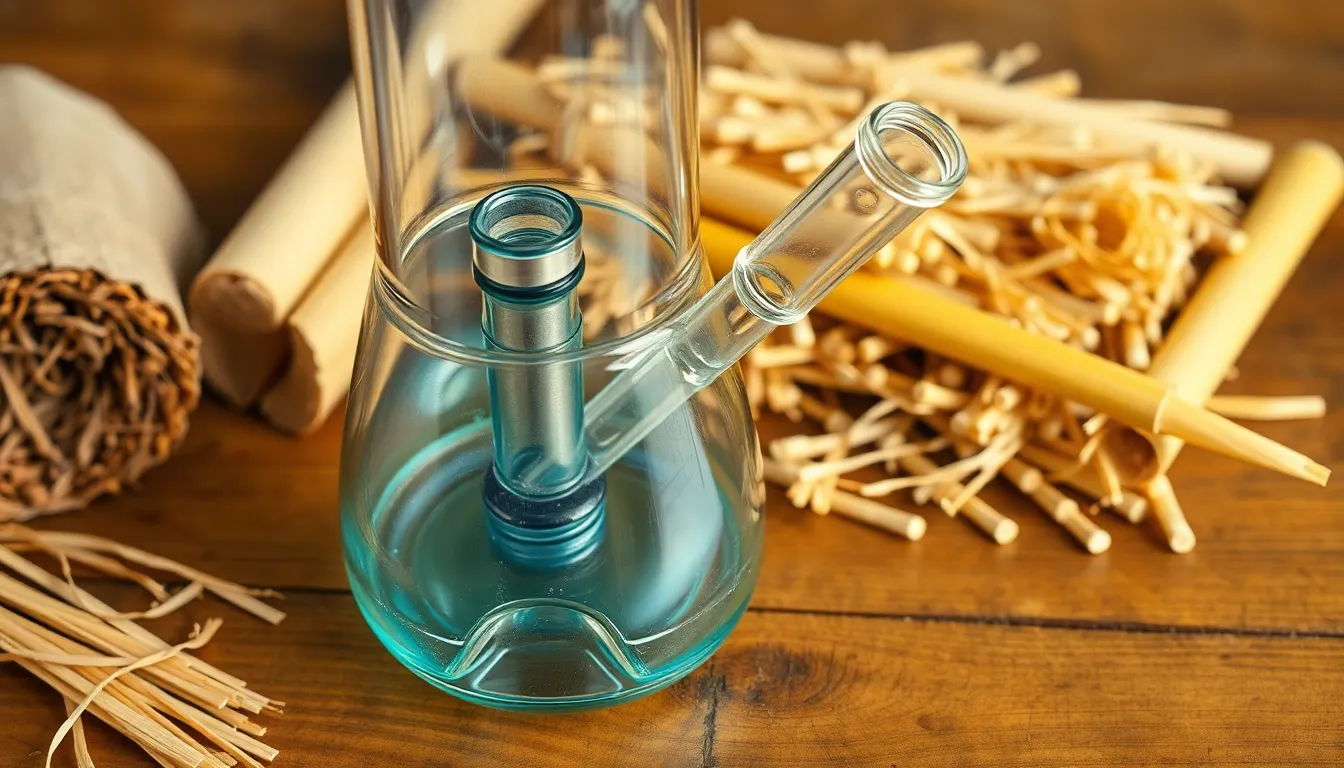When the craving hits and a trusty bong is nowhere in sight, creativity becomes your best friend. Forget the foil—there are plenty of clever ways to craft a makeshift bong that’ll have you puffing in no time. Whether you’re a seasoned pro or a curious newbie, you’ll discover that improvisation can lead to surprisingly effective results.
Table of Contents
ToggleUnderstanding the Basics of Bong Construction
Bong construction relies on understanding key elements. Crafting a functional piece requires not just creativity but also knowledge of various materials and designs.
Importance of Materials
Materials play a crucial role in bong efficiency. Glass, plastic, and metal each offer unique benefits. Glass provides excellent durability and a smooth smoking experience, while plastic is more accessible and lightweight. Metal components can enhance taste when used correctly. Ensure chosen materials are non-toxic and safe for inhalation. Common items like bottles or tubes often serve as effective bases for homemade designs.
Common Bong Design Features
Common bong designs share essential characteristics. A bowl holds the smoking material while a downstem connects it to the water chamber. Water acts as a filter, cooling smoke before inhalation. Many designs feature a carb for airflow control, allowing users to clear the chamber effectively. Bowl shapes, downstem angles, and chamber sizes vary widely, impacting overall performance. Different approaches enhance user experience, making it easy for both beginners and seasoned users to experiment.
Alternative Materials for Making a Bong

Improvisation leads to various effective materials for constructing a bong. Users can utilize items readily available at home or opt for eco-friendly alternatives.
Household Items to Use
Common household items offer innovative solutions for crafting bongs. A plastic bottle serves as a popular base, providing a sturdy structure. Needing minimal modification, it can yield impressive results. A pen tube acts as an excellent downstem; its size fits well in many bottles. Users can also repurpose an apple, making a fruity and natural option. Essentially, these items create a functional smoking apparatus with minimal effort.
Eco-Friendly Options
Eco-conscious users may appreciate sustainable choices for bong construction. Bamboo offers a strong, biodegradable option, allowing for both durability and easy disposal. Glass jars provide a reusable alternative, ensuring a clean and safe smoking experience. Corn husks, easily pliable, can create unique and biodegradable bowls. Utilizing natural materials like these not only reduces waste but also promotes a greener lifestyle while enjoying smoke.
Step-by-Step Guide: How to Make a Bong Without Foil
Creating a bong without foil is a straightforward process. By using everyday items, anyone can craft a functional smoking device.
Gathering Your Materials
Start by collecting necessary materials for the construction. A plastic bottle serves as an excellent base, while a pen tube or similar object works well as a downstem. Gather water for filtration and ensure you have scissors or a knife for cutting. These items are commonly found at home, making them convenient choices.
Constructing the Main Body
First, prepare the plastic bottle. Remove the cap and puncture a hole about a third of the way up the side. The hole should be large enough to insert the downstem snugly. Consider making another hole if you prefer a second chamber or a carb. Rinse the bottle thoroughly to eliminate any residue that might affect the taste.
Creating the Bowl and Downstem
Next, focus on crafting the bowl and downstem. For the bowl, use a small piece from the pen or another compatible object. Create a small hole in the center to hold the material. The downstem can be the pen tube, cut to an appropriate length for comfort. Ensure the angle is favorable for drawing smoke through the device.
Assembling the Bong
Complete the project by assembling all components. Insert the downstem into the hole on the bottle, ensuring it’s securely positioned underwater. Fill the bottle with adequate water to cool the smoke but avoid overfilling. Place the bowl piece on top of the downstem. After making sure everything fits tightly, your homemade bong is ready for use.
Tips for an Effective Bong Experience
Optimal conditions enhance the enjoyment of using a homemade bong. Users benefit from understanding airflow and maintenance techniques for a satisfying experience.
Ensuring Proper Airflow
Airflow plays a crucial role in the effectiveness of a bong. Create an airtight seal around the downstem to prevent air leaks. Adjust the size of the hole to ensure comfortable inhalation. A small gap can reduce draw resistance, while an overly large hole may allow smoke to escape. Testing different downstem angles helps identify the most effective position for maximizing airflow. Carefully positioned water levels also assist in filtering smoke, while not obstructing airflow.
Maintaining Your Homemade Bong
Regular maintenance prolongs the life of a homemade bong. Cleaning should occur after every few uses to prevent resin buildup. Use warm water and a brush to reach inaccessible areas. Avoid harsh chemicals, opting for natural solutions like vinegar and baking soda for effective cleaning. Inspect all components regularly to ensure they function correctly. Promptly addressing any wear or damage maintains the bong’s integrity and performance. Fresh water ensures a clean taste during each session, contributing to a more enjoyable experience.
Crafting a bong without foil opens up a world of creativity and resourcefulness. By exploring everyday materials and sustainable options, users can enjoy a personalized smoking experience that aligns with their values. The importance of understanding the basic components and ensuring safety cannot be overstated.
With simple steps and attention to detail, anyone can create an effective bong that meets their needs. Regular maintenance and optimization of airflow further enhance the experience, ensuring smooth and enjoyable sessions. Embracing improvisation not only satisfies cravings but also fosters innovation in smoking methods.




